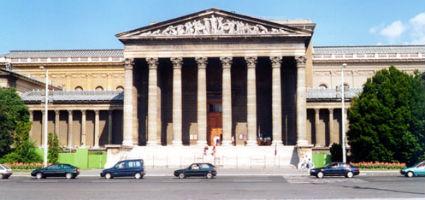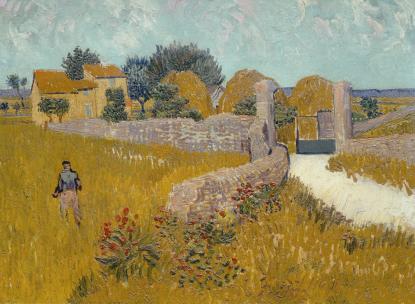2025. April 25. Friday
Budapest Museum of Fine Arts - Budapest
 |
Address: 1146, Budapest Dózsa György út 41.
Phone number: (1) 469-7100
E-mail: info@szepmuveszeti.hu
Opening hours: Tue-Sun 10:00-18:00
|
The exhibition has closed for visitors.
2006.12.02. - 2007.04.01.
Museum tickets, service costs:
|
Ticket for adults
(valid for the permanent exhibitions)
|
2800 HUF
|
/ capita
|
|
Ticket for adults
|
3200 HUF
|
|
|
Group ticket for adults
|
2900 HUF
|
|
|
Ticket for students
(valid for the permanent exhibitions)
|
1400 HUF
|
/ capita
|
|
Ticket for students
|
1600 HUF
|
|
|
Group ticket for students
|
1400 HUF
|
|
|
Ticket for pensioners
(valid for the permanent exhibitions)
|
1400 HUF
|
/ capita
|
|
Audio guide
|
800 HUF
|
|
|
Video
|
1000 HUF
|
The Museum of Fine Arts celebrates its 100th birthday with a true museum sensation. To commemorate the centenary, a large-scale exhibition from the works of Vincent van Gogh will be launched. Visitors will have the opportunity to see nearly eighty works by the Dutch painter genius. Open for three and a half months, the exhibition has every chance of becoming the one that will attract the highest number of visitors ever in Hungarian museum history.

The importance of the celebratory exhibition is demonstrated by the fact that masterpieces will arrive from more than 40 collections, from museums such as the Van Gogh Museum in Amsterdam, the Musée D'Orsay in Paris, The Metropolitan Museum of Art in New York, and the National Gallery of Art in Washington. The organisers have a two-fold objective by staging the exhibition: to bring the colourful oeuvre of van Gogh before the public, and to refine the image that has been created about his work since his death. Instead of presenting a lonely painter genius wrapped up in his art, the exhibition aims to show a consciously creating painter genius familiar with artistic traditions and ready to apply them in his art.
The large-scale exhibition is comprised of five parts. The monographic part, exhibiting van Gogh's work between 1881 and 1890, includes 43 paintings, 24 drawings and 10 graphic works (litographies and engravings). The selection places special emphasis on the early, Dutch, stage of the artist's work to show the beginnings, and then juxtaposes it to the sudden emergence of his individual style. The Parisian stage, represented by a smaller number of works, demonstrates how van Gogh mastered the impressionist style of landscape painting and the appearance of the characteristics of his own style.
As a prelude to the exhibition, artists who influenced van Gogh's art will be introduced in two parts: first, those old masters who had a determining role in the development of van Gogh’s art (Rembrandt, Delacroix, Millet, and Daubigny, among others), and, secondly, works by van Gogh's Dutch contemporaries. Reproductions of Japanese wood engravings that were also found in van Gogh's own collection will be exhibited in a separate section. The engravings, consisting of almost two dozen pieces, have been selected from Hungarian collections. As a finale, the exhibition will present an outline of the influence exerted by the Dutch master on early 20th-century Hungarian art - the Hungarian fauves, and painters such as Gyula Derkovits and Gyula Czimra.
The museum places great emphasis on how the exhibited works will be displayed: visitors will be able to see the works in the large halls placed on individual installations resembling winged altars. Each artwork will be set apart from the others and thus visitors will have the chance to experience an intimacy with the pictures like never before.
In anticipation of the great volume of interest the Museum of Fine Arts will begin selling tickets for the exhibition as early as 2nd November. The curator of the exhibition: Judit Geskó

The importance of the celebratory exhibition is demonstrated by the fact that masterpieces will arrive from more than 40 collections, from museums such as the Van Gogh Museum in Amsterdam, the Musée D'Orsay in Paris, The Metropolitan Museum of Art in New York, and the National Gallery of Art in Washington. The organisers have a two-fold objective by staging the exhibition: to bring the colourful oeuvre of van Gogh before the public, and to refine the image that has been created about his work since his death. Instead of presenting a lonely painter genius wrapped up in his art, the exhibition aims to show a consciously creating painter genius familiar with artistic traditions and ready to apply them in his art.
The large-scale exhibition is comprised of five parts. The monographic part, exhibiting van Gogh's work between 1881 and 1890, includes 43 paintings, 24 drawings and 10 graphic works (litographies and engravings). The selection places special emphasis on the early, Dutch, stage of the artist's work to show the beginnings, and then juxtaposes it to the sudden emergence of his individual style. The Parisian stage, represented by a smaller number of works, demonstrates how van Gogh mastered the impressionist style of landscape painting and the appearance of the characteristics of his own style.
As a prelude to the exhibition, artists who influenced van Gogh's art will be introduced in two parts: first, those old masters who had a determining role in the development of van Gogh’s art (Rembrandt, Delacroix, Millet, and Daubigny, among others), and, secondly, works by van Gogh's Dutch contemporaries. Reproductions of Japanese wood engravings that were also found in van Gogh's own collection will be exhibited in a separate section. The engravings, consisting of almost two dozen pieces, have been selected from Hungarian collections. As a finale, the exhibition will present an outline of the influence exerted by the Dutch master on early 20th-century Hungarian art - the Hungarian fauves, and painters such as Gyula Derkovits and Gyula Czimra.
The museum places great emphasis on how the exhibited works will be displayed: visitors will be able to see the works in the large halls placed on individual installations resembling winged altars. Each artwork will be set apart from the others and thus visitors will have the chance to experience an intimacy with the pictures like never before.
In anticipation of the great volume of interest the Museum of Fine Arts will begin selling tickets for the exhibition as early as 2nd November. The curator of the exhibition: Judit Geskó
